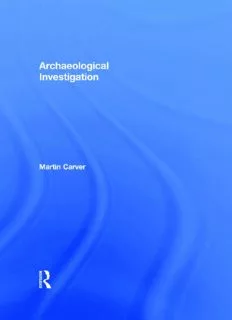
Archaeological Investigation PDF
Preview Archaeological Investigation
Arch-00-c.qxd 16/11/09 10:46 Page i AARRCCHHAAEEOOLLOOGGIICCAALL IINNVVEESSTTIIGGAATTIIOONN Martin Carver Drawing its numerous examples from around the world, Archaeological Investigation explores the procedures used in field archaeology travelling over the whole process from discovery to publication. Divided into four parts, it argues for a set of principles in Part 1, describes work in the field in Part 2 and how to write up in Part 3. Part 4 describes the modern world in which all types of archaeologist operate, academic and professional. The central chapter ‘Projects galore’ takes the reader on a whirlwind tour through different kinds of investigation including in caves, gravel quarries, towns, historic buildings and underwater. Archaeological Investigation intends to be a companion for a newcomer to profes- sional archaeology – from a student introduction (Part 1), to first practical work (Part 2), to the first responsibilities for producing reports (Part 3), and in Part 4 to the tasks of project design and heritage curation that provide the meat and drink of the fully fledged professional. The book also proposes new ways of doing things, tried out over the author’s thirty years in the field and here brought together for the first time. This is no plodding manual but an inspiring, provocative, informative and entertaining book, urging that archaeological investigation is one of the most important things society does. Martin Carver specialises in the archaeology of early Medieval Europe and field archaeology in all periods. He was a freelance archaeologist from 1972 until 1986, when he was appointed professor and head of department at the University of York. Since 2003 he has been editor of the journal Antiquity. Arch-00-c.qxd 16/11/09 10:46 Page ii This page intentionally left blank Arch-00-c.qxd 16/11/09 10:46 Page iii AARRCCHHAAEEOOLLOOGGIICCAALL IINNVVEESSTTIIGGAATTIIOONN Martin Carver Arch-00-c.qxd 16/11/09 10:46 Page iv First published 2009 by Routledge 2 Park Square, Milton Park, Abingdon, Oxon, OX14 4RN Simultaneously published in the USA and Canada by Routledge 270 Madison Avenue, New York, NY 10016 Routledge is an imprint of the Taylor & Francis Group, an informa business © 2009 Martin Carver Typeset in Folio by Keystroke, Tettenhall, Wolverhampton Printed and bound in Great Britain by MPG Books Group Ltd All rights reserved. No part of this book may be reprinted or reproduced or utilised in any form or by any electronic, mechanical, or other means, now known or hereafter invented, including photocopying and recording, or in any information storage or retrieval system, without permission in writing from the publishers. British Library Cataloguing in Publication Data A catalogue record for this book is available from the British Library Library of Congress Cataloging in Publication Data A catalog record for this book has been requested ISBN 13: 978–0–415–48918–8 (hbk) ISBN 13: 978–0–415–48919–5 (pbk) Arch-00-c.qxd 16/11/09 10:46 Page v To my friends pictured within. Arch-00-c.qxd 16/11/09 10:46 Page vi This page intentionally left blank Arch-00-c.qxd 16/11/09 10:46 Page vii TTAABBLLEE OOFF CCOONNTTEENNTTSS List of illustrations xiii Acknowledgements and picture credits xxxiii Preface xxxvii PART 1: PRINCIPLES 1 How archaeological fieldwork relates to theory and the society in which it is practised. The demands of research, the needs of conservation and the rights of stakeholders – and how these can be reconciled. Chapter 1: The stuff 3 A prodigious variety 3 Methods of study 7 Defining archaeological strata 15 Archaeological vocabulary 19 Conclusion 22 Chapter 2: Approaches 25 What do we want from fieldwork? 25 Empirical to reflexive: five approaches 27 Evaluative archaeology 32 Field Research Procedure 35 Chapter 3: Field Research Procedure: a framework 39 A value-led project: the Sutton Hoo burial ground 39 Stage 1 Reconnaissance 41 Stage 2 Evaluation 41 Stage 3 Project design 48 vii CONTENTS Arch-00-c.qxd 16/11/09 10:46 Page viii Stage 4 Field investigation 52 Stage 5 Analysis 55 Stage 6 Publication 57 Reflection 57 PART 2: IN THE FIELD 61 Here I review techniques and their applications for five principal types of field operation. Chapter 4: Landscape survey 63 First day in the field 63 Techniques 65 Applications 73 In sum... 86 Chapter 5: Site survey 89 Looking at sites 89 Techniques 89 Applications 102 In sum... 109 Chapter 6: Excavation 113 First day on a dig 113 On method: three ways of dissecting strata 117 On procedure: Recovery Levels 124 Recording 138 The course of an excavation 146 In sum... 148 Chapter 7: Projects galore: Integrated Field Research 151 A cave site in Greece 152 A shell mound in Kentucky 154 On the gravels: a timber palace in Northern England 156 On the sand: a Neolithic village by the Seine 159 A turf hall in Norway 161 A stone fort in Sweden 164 A tell site in Syria 165 A terp site in Holland 167 A Maya ruin in Belize 170 viii CONTENTS Arch-00-c.qxd 16/11/09 10:46 Page ix Getting wet 184 In a shallow Alpine lake 185 Diving deep off Turkey 188 A villa by the Adriatic 171 Tomb tableaux in China 173 Studying standing structures 174 Urban archaeology 179 Getting wet: in Florida, France and Turkey 184 In sum... 191 PART 3: WRITING UP 195 This shows how the records gathered in the field are studied and reported to researchers, to clients and to the public. Chapter 8: Analysis 197 The tasks: manage, assess and analyse 197 The analytical programme 202 Case study: Saddler Street, Durham 205 Conclusion 215 Chapter 9: Assemblage 217 Retrieval 217 Analysis 224 Artefacts 225 Biological (biota) samples 231 Interpreting site assemblages 238 Chapter 10: Space 245 Scales of space 245 Spatial patterns from excavation 246 Plotting objects 247 Mapping features and structures 250 Spatial patterns from site survey 252 Spatial patterns in the landscape 256 Pattern-seeking by computation 258 Chapter 11: Chronology 267 The business of chronology 267 ix CONTENTS
Description: